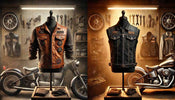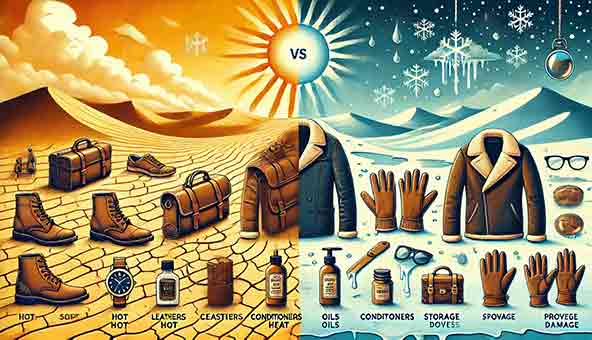
Leather vs Textile: Why Bikers Still Prefer Leather Vests?
, by Syed Khawar Bukhari, 8 min reading time

, by Syed Khawar Bukhari, 8 min reading time
In the world of motorcycling, the debate between leather vests and textile vests remains as passionate today as it was decades ago. While modern textiles offer impressive innovations, many riders continue to swear by the time-honored toughness and style of genuine leather. This article dives deep into the factors that keep leather vests at the forefront of biker fashion and function—examining history, protection, comfort, maintenance, aesthetics, cost, and sustainability—to explain why leather remains the gold standard for serious riders.
Leather’s storied connection to motorcycles dates back to the early 1900s, when pioneers of the road sought durable, wind-resistant garments for cross-country trips. The iconic black leather jacket and matching vest quickly became symbols of rebellion and comradery among riders:
Origins in Racing: Early racers favored leather for its abrasion resistance and ability to mold to the body over time, enhancing aerodynamics and rider confidence.
Cultural Icon: Post-World War II veterans popularized biker clubs and leather attire, cementing the vest as a statement of identity and brotherhood.
Enduring Legacy: Today’s manufacturers still draw on classic cuts and panel designs first introduced in the 1930s, underscoring leather’s timeless appeal.
When it comes to personal safety, nothing beats thick bovine hide:
Abrasion Resistance
Leather: With natural fibers tightly interwoven, full-grain leather can withstand high‐speed slides without tearing (up to 1,200 °C melting point) and actually stiffens rather than fails catastrophically.
Textile: Advanced fabrics like Cordura® or Kevlar® deliver improved breathability and modular layering, but many fall short of leather’s sheer puncture toughness under extreme conditions.
Impact Mitigation
Leather Vests: Though vests lack hard armor, the dense hide still offers a substantial buffer against road rash and flying debris.
Textile Vests: Often incorporate pockets for armor inserts (CE-rated pads), allowing customization but adding bulk and moving parts that can shift during a crash.
Weather Resistance
Leather: Naturally water-repellent when treated, leather vests create a wind barrier that’s unsurpassed—especially valuable on cold rides.
Textile: Many textile vests use waterproof membranes (e.g., Gore-Tex®), but seams and zippers remain potential leak points over time.
Modern bikers demand gear that adapts to changing climates and long hauls without sacrificing comfort:
Break-In vs. Breakaway
Leather: Provides a “broken-in” feel after several rides, conforming closely to the body for improved ergonomics.
Textile: Lightweight straight out of the box, but may flap in high winds until fully stretched and shaped to the rider.
Temperature Control
Leather Vests: In hot weather, strategic perforations and vest designs allow airflow while preserving core protection. In cooler climates, leather retains heat and blocks wind chill.
Textile Vests: Often feature zip-out liners and vents, giving riders modular options—but risk unwanted drafts if panels are left open.
Fit and Mobility
Leather: Premium hides offer relevant stretch and elasticity that cushions movement; panel articulation further enhances flexibility.
Textile: Elasticized gussets and adjustable straps can tailor fit, yet they add complexity and potential points of failure.
Keeping your vest in peak condition requires different approaches for leather and textile fabrics:
Cleaning
Leather Vests: Wipe with a damp cloth, use specialized leather cleaners, and apply conditioner monthly to prevent cracking.
Textile Vests: Machine-washable in most cases, though repeated launderings can degrade water-repellent coatings and fade colors.
Repairs
Leather: Small tears or scratches can be patched or buffed out; a professional cobbler can re-edge the collar and sleeves for a fraction of replacement cost.
Textile: Specialized seam-sealing kits repair minor splits, but large tears often require full-panel replacement.
Service Life
Leather: A well-cared-for vest can last 10–20 years, growing more supple and unique with every ride.
Textile: Technological advances mean high-end vests can endure 5–7 years under heavy use before fading and shrinkage reduce protective qualities.
Beyond utility, leather vests deliver a visual signature unmatched by modern synthetics:
Timeless Design: From classic shotgun cuts to studded chaps-by-vest hybrids, leather adapts to countless silhouettes and customizations.
Patina and Character: Genuine leather thrives on aging—scuffs, discolorations, and unique wear patterns tell the story of each ride.
Customization Options: Embossing, hand-tooled artwork, patches, and metallic hardware create truly one-of-a-kind pieces that rally recognition at bike rallies worldwide.
Textile vests, while versatile in color and geometry, rarely match the rich texture and depth of a well-worn hide.
At first glance, price tags can influence the choice:
Upfront Investment
Leather Vests: Quality hides and craftsmanship demand higher costs—typically ranging from $200 to $600 for mid-range to premium models.
Textile Vests: Entry-level options start around $100, while advanced multi-layer designs climb to $350–$500.
Long-Term Value
Leather: Exceptional longevity and the potential for resale at vintage prices often offset initial expense.
Textiles: Lower initial cost but faster degradation can mean multiple replacements over the same time span.
Riders focused on total cost of ownership often find that leather vests deliver superior return on investment.
Sustainability matters more every year, and both materials carry distinct footprints:
Leather: A byproduct of the meat industry, leather uses tanning chemicals that require responsible disposal; however, a single vest’s decades-long lifespan reduces overall waste.
Textile: Synthetic fibers rely on petrochemicals and microplastic shedding, yet some manufacturers now offer recycled polyester blends and PFC-free DWR coatings.
Bikers seeking eco-friendly gear often weigh longevity (favoring leather) against raw material renewability (favoring recycled textiles).
While textile vests continually push the envelope with cutting-edge membranes, modular armoring, and weight savings, leather vests remain the preferred choice for many due to:
Unrivaled abrasion resistance and wind-blocking performance
Natural comfort through break-in and body-molding properties
Rich aesthetic depth and personalized patina development
Outstanding service life, providing decades of reliable service
Cultural heritage and symbolic resonance within biker communities
Ultimately, the decision between leather and textile comes down to personal priorities—whether you value the rugged tradition and lasting value of leather, or the technical versatility of textiles. For bikers who seek a blend of protection, style, and heritage that endures as the years roll on, leather vests continue to hold an unrivaled place in the saddle.


